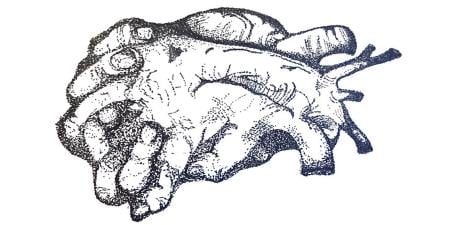Abstract
HIV/AIDS exceptionalism promoted compassion, garnered funding, built institutions, and shaped regulatory and research agendas under emergency conditions. Globally, however, HIV/AIDS exceptionalism has further fragmented fragile health service delivery systems in vulnerable, marginalized communities and created perverse incentives to influence seropositive individuals’ behaviors. Even where HIV epidemics are viewed as “controlled” or “resolved” (as in the United States), ending AIDS requires eliminating exceptionalism, normalizing justice-based approaches to HIV care, and explicitly acknowledging how power dynamics shape popular narratives and practices.
HIV/AIDS Research
When we began planning this essay, we talked about the experiences that led us to HIV/AIDS research.
A.B.: In 1997, I enrolled in my first (and only) undergraduate anthropology course, “AIDS in International Perspective.” It was a small seminar—no more than a dozen students—for which we read hundreds of pages per week and, on a weekly basis, met someone from the AIDS community in southern New England. The course’s instructors also required us to volunteer in one of the many AIDS programs in our small state. I joined an AIDS peer-education group geared toward out-of-school youth and became the group’s co-leader the following year. Over the next 5 years, I worked for prison doctors who specialized in HIV treatment, interned in the Department for HIV/AIDS Prevention at the Centers for Disease Control and Prevention (CDC), and consulted for a range of HIV/AIDS programs for international nongovernmental organizations in sub-Saharan Africa. Ten years after that first anthropology course, I completed dissertation fieldwork among HIV-positive Sierra Leoneans, funded by an AIDS training grant from the National Institutes of Health (NIH).
T.S.: From 1998 to 2001, I worked for 2 nonprofits alongside renowned international scholars in the social sciences and medicine from sub-Saharan Africa and the United States, conducting research and managing fellowship programs focused on higher education, social medicine, and medical ethics. On extended work assignments to South Africa and Ghana, I first became attuned to the devastating effects of HIV/AIDS. The prevalence rate in Ghana at this time was 3% to 4%, and women, especially commercial sex workers, were severely affected by the epidemic.1 In South Africa, AIDS more than doubled the country’s mortality rate; AIDS-related deaths accounted for half of the nation’s total death rate from 1999 to 2000.2 I accompanied colleagues to villages and cities where makeshift cemeteries had cropped up, children were caring for ailing parents, and activists were protesting for the widespread provision of antiretroviral drugs. Forever changed by this experience, I enrolled in a public health program and worked on one of the longest-running longitudinal studies of people living with HIV. A few years later, I completed my NIH-funded dissertation fieldwork in anthropology with HIV-positive Haitians living in South Florida and finished postdoctoral training in HIV and sexually transmitted diseases at the CDC.
We provide these autobiographical details not to establish our legitimacy as AIDS experts, but to demonstrate the extensive reach of what Cindy Patton long ago referred to as “the AIDS industry”3 and the exceptional status afforded to HIV/AIDS. In this essay, we address what it has meant for the disease to have achieved exceptional status—in our work, for our interlocutors, for the institutions we routinely encountered as a condition of that exceptionalism. We describe this trajectory of AIDS’ exceptionalism within a broader history and political economy, briefly examining the challenges that lie ahead as we seek the end of AIDS.
HIV/AIDS Exceptionalism
The idea that HIV/AIDS is an exceptional disease requiring an equally exceptional response has a fraught history.4,5,6 The new viral syndrome emerged at a time when public health and clinical medicine had become confident in their ability to identify, trace, diagnose, and treat infectious diseases with relative efficiency and efficacy. AIDS shattered that confidence when it was first recognized among White, gay men in US cities like San Francisco, Los Angeles, and New York City in the early 1980s. It initially appeared to affect mostly young, otherwise healthy, individuals in ways that confounded the clinicians and epidemiologists who first encountered it.7,8
By 1983, the designation of AIDS risk focused on a handful of groups, collectively called the “4H club”: homosexuals, hemophiliacs, Haitians, and heroin users. (Others—notably David Black, author of The Plague Years: A Chronicle of AIDS, the Epidemic of Our Times 9—added “hookers” to the club’s membership roster.) The specious and discriminatory lumping of nationality, sexual orientation, cultural practice, occupation, and biological traits guided health policy, clinical practice, and public messaging, producing a number of deleterious effects globally.10,11,12 Among those effects was the exclusion of the general population from those perceived to be at risk for or living with HIV/AIDS3,13 and the further stigmatization of and discrimination against already marginalized groups.14,15 It soon became clear to caregivers, clinicians, social science researchers, and activists that the ripple effects of AIDS in families, communities, and wider systems necessitated a broad-based response that addressed not only the biological and clinical facets of the disease, but also its political, social, and economic dimensions.12,16,17,18 HIV/AIDS thus constituted a public health emergency of an unprecedented nature.19,20
As is the case during emergencies of this magnitude, the institutions, practices, and norms forged in crisis may persist long after the crisis has receded from view. HIV’s exceptional status, in other words, has (re)produced durable, resilient institutions, norms, and practices worldwide. Within US government agencies like the NIH and the Food and Drug Administration, expedited trials for experimental therapies and potential vaccines ensued in response to aggressive lobbying by AIDS activists.8,21 At the international level, entirely new institutions were established to coordinate AIDS activities. The Joint United Nations Program on HIV/AIDS (UNAIDS) was established in 1994,20 while the World Health Organization’s 3-by-5 Initiative was created to improve access to highly active antiretroviral therapies to 3 million individuals in poor countries by the end of 2005.22
Funding mechanisms for HIV/AIDS programming expanded globally as well. Among the best-known financing efforts are the Global Fund to Fight AIDS, Tuberculosis and Malaria, established in 2002 by a transnational private-public partnership; George W. Bush’s President’s Emergency Plan for AIDS Relief; and AIDS-specific funding through US government agencies like the NIH, CDC, and the Substance Abuse and Mental Health Services Administration. AIDS has also reconfigured public health governance in the form of national AIDS secretariats in low- and middle-income countries and the enshrinement of “AIDS czars” within governmental agencies.23,24
Of course, institutional and structural changes wrought by HIV’s exceptional status were not solely generated through or by powerful institutions and individuals. Activists involved in social movements and political struggles organized to address inequalities rooted in misogyny, patriarchy, heterosexism, racism, and capitalism were at the forefront and influenced early HIV activism.3,25,26,27,28 Residential segregation and affordable housing, labor, wages and livelihoods, incarceration, and access to comprehensive and affordable health care were among the issues that activists tried to address not only for those living with HIV/AIDS, but also for vulnerable populations more broadly.6,29 Such movements paved the way for social, legal, and political change concerning life-and-death matters, including access to treatment, the ethics of experimentation, and knowledge production.30
Durable institutions never fully cede their power; instead, they tend to absorb and coopt the movements that initially pushed for social change.
The AIDS-centered marketing, media, and advocacy campaigns of the 1990s and 2000s ushered in a new era of social marketing,20 with a wide range of organizations committed to raising public consciousness and capital to support AIDS prevention, treatment, and support programs (eg, ACT UP, Red Ribbon Campaign, Product RED).20 And, finally, new legal and legislative frameworks emerged in the wake of discrimination, stigma, and fear of HIV-positive individuals, including the Ryan White Care Act and the development of policies addressing workplace discrimination, privacy, and the criminalization of AIDS.23,24
Yet our work also shows that durable institutions never fully cede their power; instead, they tend to absorb and coopt the movements that initially pushed for social change.31,32 Nongovernmental organizations, once devoted to structural interventions to address HIV/AIDS but now funded by a growing nonprofit industrial complex, began to fill a void in areas where state-sponsored social service resources and offerings were scarce.33 Field-based, empirical studies highlight how far-ranging HIV-specific programming had distorting effects, particularly among communities where deep disparities and inequities persist. A.B.’s ethnographic research in Freetown, Sierra Leone, for example, suggests that the quality of and access to health care may be slightly better for HIV-positive urban residents than seronegative individuals of the same social status; notably, other people and other health issues were marginalized in a siloed system in which HIV constitutes its own subset of health priorities and social issues.34
The expectation that the benefits of HIV programming—better labs, better access to pharmaceuticals, better training for clinical staff, better health education, and outreach that attends to social and economic needs—would trickle “sideways” to other health issues and “down” to the most vulnerable was not fully realized in the first decade of widespread access to antiretroviral therapies.35,36,37,38 The HIV industry in Freetown offered a means for poorer HIV-positive individuals to improve their status through participation in workshops and international forums dedicated to people living with HIV/AIDS, to join support networks tailored to their condition, and to access resources allocated for HIV-positive people.35,38,39
Continued Inequity
In the US South, HIV is a continuing crisis linked to historical legacies of segregation, underfunding of safety nets, retreating welfare states, and federal funding directives. T.S. and colleagues’ ethnographic research has documented the severe disconnect between official discourses of unified global HIV response and local realities.40,41 Although HIV programs and policies aimed at allocating resources to populations with the highest disease burden, African Americans and Haitian Americans were not afforded equal access to necessary resources—despite their disproportionately higher rates of infection, morbidity, and mortality due to health financing structures and discriminatory policies.31 HIV exceptionalism also makes it possible to displace the responsibility of care from social welfare and public health institutions to individuals themselves, so that the continued rise in HIV disparities becomes attributable to individual and collective risk, rather than to the broader structural constraints generated by institutional directives.
As HIV policy discourse and practice focuses on the end of AIDS, we are faced with 2 significant challenges, which are also artifacts of decades of exceptionalist planning and programming: living with a chronic HIV infection and rising and new infections among racial and ethnic minorities, transgender people, and users of injection drugs. In this third decade of life-prolonging antiretroviral therapies, what does it mean to grow old with HIV? What might a lifetime on these therapies do to aging bodies? Much of HIV funding continues to focus on biotechnical advances rather than on developing better knowledge of antiretroviral drugs’ effects on aging and older people. T.S. and colleagues’ ethnographic research among aging women and men, for example, suggests that medications and their weathering effects might be responsible for other chronic conditions, frailty, and disability.38,41,42,43
Controlling rising and new infections in certain groups in the US South and the Global South, where many HIV-positive people reside and most new infections occur, is challenged by health systems that are fragmented and under-resourced in ways that make the interventions outlined in the Ending the HIV Epidemic strategy difficult.44 The US South, for example, simply does not have the human, infrastructural, and organizational resources to develop comprehensive prevention programs, nor has it been adequately equipped to provide quality and timely care for the management of HIV.45 This lack of resources is especially challenging for a population suffering from chronic conditions associated with HIV and aging.
The End of AIDS
Going forward, as we look to ending AIDS, we must acknowledge the strides made over the course of 40 years—particularly as the laser focus on the disease and its biological, social, political, and economic dimensions has channeled activism into changing regulatory mechanisms, institutional practices, and sociocultural norms. But a thriving AIDS industry has made these achievements under conditions in which interlocking oppressions and concomitant privileges have continued to shape the risk of contracting and dying from the disease in the first place. Thus, we must also consider how HIV’s exceptional status, which in a sense served to disrupt and unsettle conservative institutions, also helped to reproduce and entrench the inequalities that set the machine in motion. In this brief commentary, we have shown how this dynamic most seriously affects low- and middle-income countries in sub-Saharan Africa, where exceptionalist donor agendas have skewed health systems away from comprehensive primary care. In high-income countries like the United States, increasing incidence among some racial and ethnic minority populations highlights how long-standing issues related to uneven resource distribution, racism and discrimination, and lack of access to care continue to drive acute racial disparities in HIV.46,47 As we discuss the end of AIDS, then, we would be wise to revisit its beginnings, before AIDS exceptionalism became institutionalized in ways that elided broader justice struggles that AIDS merely amplified. Doing so will enable us to enlarge and extend an agenda for care and justice rather than merely reproduce inequalities engendered through exceptionalism.
References
-
National AIDS/STI Control Programme, Ministry of Health, Ghana. Estimating national HIV prevalence in Ghana using sentinel surveillance data. Policy Project. August 1, 2001. Accessed December 4, 2020. http://www.policyproject.com/pubs/countryreports/GhanaNatEst2000.pdf
-
Dorrington R, Bourne D, Bradshaw D, Laubscher R, Timæus IM. The impact of HIV/AIDS on adult mortality in South Africa. Medical Research Council, South Africa; September 2001. Accessed March 9, 2021. https://www.researchgate.net/profile/Ria-Laubscher/publication/221943220_The_impact_of_HIVAIDS_on_adult_mortality_in_South_Africa/links/0c960516e5a8a24a38000000/The-impact-of-HIV-AIDS-on-adult-mortality-in-South-Africa.pdf
-
Patton C. Inventing AIDS. Routledge; 1990.
-
Smith JH, Whiteside A. The history of AIDS exceptionalism. J Int AIDS Soc. 2010;13:47.
-
Brier J. Infectious Ideas: US Political Responses to the AIDS Crisis. University of North Carolina Press; 2009.
- Dionne KY, Gerland P, Watkins S. AIDS exceptionalism: another constituency heard from. AIDS Behav. 2013;17(3):825-831.
-
Shilts R. And the Band Played On: Politics, People, and the AIDS Epidemic. St Martin’s Press; 1987.
-
Epstein S. Impure Science: AIDS, Activism, and the Politics of Knowledge. University of California Press; 1996.
-
Black D. The Plague Years: A Chronicle of AIDS, the Epidemic of Our Times. Simon & Schuster; 1986.
-
Farmer P. AIDS and Accusation: Haiti and the Geography of Blame. University of California Press; 2006.
- Parker R. Acquired immunodeficiency syndrome in urban Brazil. Med Anthropol Q. 1987;1(2):155-175.
- Parker R. Sexuality, culture, and power in HIV/AIDS research. Annu Rev Anthropol. 2001;30(1):163-179.
-
Treichler PA. How to Have Theory in an Epidemic: Cultural Chronicles of AIDS. Duke University Press; 1999.
-
Hammonds E. Missing persons: African American women, AIDS, and the history of disease. In: Guy-Sheftall B, ed. Words of Fire: An Anthology of African-American Feminist Thought. New Press; 1995:434-449.
-
Grover JZ. AIDS: keywords. In: Crimp D, ed. AIDS: Cultural Analysis/Cultural Activism. MIT Press; 1987:17-30.
- Schoepf BG. Ethical, methodological and political issues of AIDS research in Central Africa. Soc Sci Med. 1991;33(7):749-763.
- Farmer P, Kleinman A. AIDS as human suffering. Daedalus. 1989;118(2):135-160.
-
Nguyen VK. The Republic of Therapy: Triage and Sovereignty in West Africa’s Time of AIDS. Duke University Press; 2010.
- Mann JM. The global AIDS situation. World Health Stat Q. 1987;40(2):185-192.
-
Piot P. AIDS: Exceptionalism revisited. Lecture presented at: London School of Economics and Political Science; May 15, 2008; London, UK. Accessed December 12, 2020. https://www.unaids.org/sites/default/files/media_asset/20080526_pp_lse_lecture_en_2.pdf
-
Smith RA, Siplon PD. Drugs Into Bodies: Global AIDS Treatment Activism. Praeger; 2006.
-
The 3 by 5 Initiative: human capacity-building for scaling up HIV treatment. World Health Organization. https://www.who.int/3by5/publications/documents/capacity_building/en/
- Burris S. Studying the legal management of HIV-related stigma. Am Behav Sci. 1999;42(7):1229-1243.
- Lin L, Liang BA. HIV and health law: striking the balance between legal mandates and medical ethics. Virtual Mentor. 2005;7(10):687-692.
-
Watkins-Hayes C. Intersectionality and the sociology of HIV/AIDS: past, present, and future research directions. Annu Rev Sociol. 2014;40:431-457.
- Beyrer C. LGBT Africa: a social justice movement emerges in the era of HIV. SAHARA J. 2012;9(3):177-179.
- Jacobs S, Johnson K. Media, social movements and the state: competing images of HIV/AIDS in South Africa. Afr Stud Q. 2007;9(4):127-152.
- Parker RG. Civil society, political mobilization, and the impact of HIV scale-up on health systems in Brazil. J Acquir Immune Defic Syndr. 2009;52(suppl 1):S49-S51.
-
Richey LA, Ponte S. Brand Aid: Shopping Well to Save the World. University of Minnesota Press; 2011.
-
Cohen CJ. The Boundaries of Blackness: AIDS and the Breakdown of Black Politics. University of Chicago Press; 1999.
-
Benton A. HIV Exceptionalism: Development Through Disease in Sierra Leone. University of Minnesota Press; 2015.
-
Sangaramoorthy T. Treating AIDS: Politics of Difference, Paradox of Prevention. Rutgers University Press; 2014.
-
Mbali M. South African AIDS Activism and Global Health Politics. Palgrave Macmillan; 2013.
-
INCITE!, ed. The Revolution Will Not Be Funded: Beyond the Non-profit Industrial Complex. Duke University Press; 2007.
-
Shiffman J. Has donor prioritization of HIV/AIDS displaced aid for other health issues? Health Policy Plan. 2008;23(2):95-100.
-
Shiffman J, Berlan D, Hafner T. Has aid for AIDS raised all health funding boats? J Acquir Immune Defic Syndr. 2009;52(suppl 1):S45-S48.
- Benton A. Exceptional suffering? Enumeration and vernacular accounting in the HIV-positive experience. Med Anthropol. 2012;31(4):310-328.
- Benton A, Sangaramoorthy T, Kalofonos I. Temporality and positive living in the age of HIV/AIDS—a multi-sited ethnography. Curr Anthropol. 2017;58(4):454-476.
-
Sangaramoorthy T. Chronicity, crisis, and the “end of AIDS.” Glob Public Health. 2018;13(8):982-996.
-
Sangaramoorthy T, Richardson J. Why the South still has such high HIV rates. Conversation. June 4, 2017. Accessed January 28, 2021. https://theconversation.com/why-the-south-still-has-such-high-hiv-rates-76386#:~:text=Root%20causes%20of%20the%20enduring,suburban%20areas%20and%20rural%20counties
- Sangaramoorthy T, Jamison A, Dyer T. Intersectional stigma among midlife and older Black women living with HIV. Cult Health Sex. 2017;19(12):1329-1343.
- Sangaramoorthy T, Jamison A, Dyer T. Older African Americans and the HIV care continuum: a systematic review of the literature, 2003-2018. AIDS Behav. 2019;23(4):973-983.
- Sangaramoorthy T, Jamison AM, Dyer TV. HIV Stigma, retention in care, and adherence among older Black women living with HIV. J Assoc Nurses AIDS Care. 2017;28(4):518-531.
-
US Department of Health and Human Services. What is Ending the HIV Epidemic: A Plan for America? HIV.gov. Updated October 14, 2020. Accessed January 28, 2021. https://www.hiv.gov/federal-response/ending-the-hiv-epidemic/overview
-
Villarosa L. America’s hidden HIV epidemic: why do America’s Black gay and bisexual men have a higher HIV rate than any country in the world? New York Times. June 6, 2017. Accessed December 12, 2020. https://www.nytimes.com/2017/06/06/magazine/americas-hidden-hiv-epidemic.html
-
Colasanti J, Armstrong WS. A glimpse of the early years of the human immunodeficiency virus epidemic: a fellow’s experience in 2014. Open Forum Infect Dis. 2014;1(2):ofu035.
-
HIV in the United States and dependent areas. Centers for Disease Control and Prevention. Reviewed November 24, 2020. Accessed February 4, 2021. https://www.cdc.gov/hiv/statistics/overview/ataglance.html



